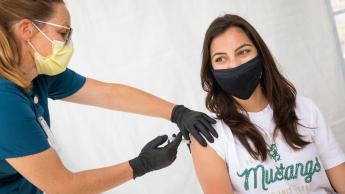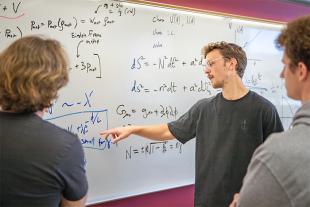Ask an Expert: How do COVID-19 vaccines actually work?

For months, COVID-19 vaccines have dominated the news — from clinical trial data, to first shots in arms of health care workers, to the national rollout. Now that three vaccines are authorized for emergency use and are available to everyone over the age of 16 nationwide, more than 200 million doses have made it into the arms of Americans. But many people are still deliberating about vaccination — and wading through a swell of misinformation.

Cal Poly News asked immunologist and biological sciences Professor Candace Winstead to help explain how these vaccines work and why everyone — including young people — should roll up their sleeves to help end the pandemic.
How do the COVID-19 vaccines work?
All three of the currently authorized vaccines available in the U.S. work by delivering instructions for our cells to make the SARS-CoV-2 (coronavirus) spike protein. The vaccines differ a bit in their delivery mechanisms: Pfizer/BioNTech and Moderna vaccines coat virus spike mRNA in fat (aka lipid nanoparticles) for delivery; Johnson & Johnson uses a weak cold virus (adenovirus) vector.
Once our cells get the instructions, they make copies of the spike protein, show it to our immune system and instruct it to make a response. The immune response involves generating antibodies that block virus entry and T-cells which kill virally infected cells.
Data so far indicate that these vaccines also generate persistent immune memory, which is a trained response that is faster and better than the initial encounters. This immune memory from the vaccine will last for many months or possibly years, and early data indicate it is better than the immune response and memory generated by the actual virus infection.
Importantly, there is no actual whole SARS-CoV-2 virus involved in these vaccines, so you cannot get COVID-19 from the vaccines. The instructions delivered to our cells are temporary, do not integrate into our genomes, and only persist for long enough to initiate immune responses.
What’s special about the development process that generated the vaccines?
Decades of behind-the-scenes research went into developing the vaccines we are using today, which is part of the reason the currently authorized vaccines were able to be developed on time and be so effective.
The Johnson & Johnson vaccine uses a viral vector platform that was developed and previously validated for Ebola virus vaccine responses. The Pfizer/BioNTech and Moderna mRNA vaccines would not have been developed without the pioneering work of Dr. Katalin Karikó and her collaborators originating in the 1990s. This group did the groundbreaking but rather mundane work to make the notoriously unstable mRNA molecules less fragile.
They, and others, also determined how to design these mRNAs to dampen the initial host response so they could be used clinically. Both the viral vector and mRNA platforms are quite flexible and can easily pivot to accommodate the generation of booster shots for the variants, should they be needed.
How do we know the vaccines are safe and effective?
All of the vaccines passed through large Phase 3 clinical trials, and their results were scrutinized by multiple agencies and experts for both safety and efficacy. In addition, our typical vaccine monitoring systems have been greatly expanded as these vaccines roll out into the community. This post-vaccine monitoring is designed to capture any clusters of unusual side effects or medical events. At this point, tens of millions of doses have been administered, and the vaccines have been demonstrated to be incredibly safe, with only relatively mild and expected side effects noted.
Recently, the system worked to address the rare but severe blood clot that appeared in about 15 people of the nearly 7 million who received the Johnson and Johnson vaccine. The U.S. paused administering that vaccine to conduct a thorough data review and targeted education of health care providers. Now Johnson and Johnson’s vaccine is recommended for continued use — an important example of this monitoring system working properly.
In addition, the efficacy against symptomatic COVID-19 shown in the Phase 3 trials has translated into real world effectiveness against symptomatic disease and infection. These are exceptionally good vaccines at preventing severe disease requiring hospitalization and preventing death, and vaccinated people are more likely to experience a mild infection even if they should contract COVID-19.
What is herd immunity?
First off, I much prefer the term "community protection" — it is more descriptive. This is the demonstrated phenomenon that occurs when a certain percentage of a given population are immune to a pathogen through either vaccination or infection. Once the threshold is reached, cases drop — even in the non-immune population — and a new outbreak can no longer take off. This level of immunity then protects the vulnerable people who do not have access to vaccines, those who cannot get vaccinated, and those for whom the vaccine may be less effective.
This concept is traditionally applied by immunologists and public health epidemiologists towards protection elicited by vaccination — as for many of the diseases we are concerned with, vaccination-induced protection is much safer than natural immunity.
For COVID-19, this threshold is thought to be between 70-85% of the population having immunity. If we didn’t have vaccines for COVID-19, we wouldn’t be able to reach herd immunity without a significant amount of suffering and death. So we are lucky to have such safe, effective vaccines!
The herd immunity or community protection threshold is based on how contagious a pathogen is and can vary with viral characteristics, like the presence of variants, and population characteristics, such as density and age. It can also still depend on the applications of different non-pharmaceutical interventions, like universal masking or social distancing as cases are coming down.
Younger people now have access to vaccines. What does that mean for this phase of the pandemic?
This is great news! Though young people are at lower risk for COVID-19, they have been important agents of transmission of the virus, which then ends up infecting more vulnerable people.
We need a combination of different measures, of which vaccination is an important tool, in order to drive disease transmission down, to be able to safely resume many activities and effectively end the pandemic.
In addition, though younger folks are at lower risk, this is not the same thing as no risk, and it is still less risky to get vaccinated than to get infected. We are learning more about long term effects of SARS-CoV-2, and even people with mild infections can take a long time to recover back to normal. Further, people with asymptomatic and mild COVID-19 have gone on to get Long COVID, which affects multiple body systems — we do not currently know what predisposes a person to these long-term effects. So, vaccination protects both the individual and the community!




